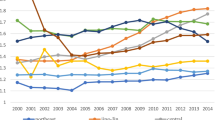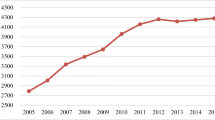Abstract
This study attempts to analyse the influence of urbanization, economic growth, and population size on residential carbon emissions in the South Asian Association for Regional Cooperation (SAARC) member nations for the period 1994 to 2013. To do so, we employ an augmented STIRPAT model in an ecological analytic framework with a fixed effect regression model that incorporates Driscoll and Kraay standard errors. The results show that population size and per capita GDP are leading drivers of high carbon emissions in the SAARC countries. The empirical results show that a U-shaped relationship exists between urbanization and residential carbon emissions: residential carbon emissions initially decrease with an increase in urbanization, reach a turning point at 25.33% and then increase with urbanization. Thus, our findings suggest a need for stronger national policies to control the impact of urbanization and population growth on residential carbon emissions in the SAARC member countries.
Graphic abstract


Source: Based on data provided by the International Energy Agency (2015) for the period 1994–2013

Source: Based on the WDI, published by World Bank (2016)

Source: Based on the WDI, published by the World Bank (2016)
Similar content being viewed by others
References
ADB (2012) Key indicators for Asia and the Pacific 2012. Manila. Retrieved March 18, 2019 from www.adb.org/publications/key-indicators-asia-and-pacific-2012
Anser MK (2019) Impact of energy consumption and human activities on carbon emissions in Pakistan: application of STIRPAT model. Environ Sci Pollut Res 26(13):13453–13463
Azam M, Khan AQ (2016) Urbanization and environmental degradation: evidence from four SAARC countries—Bangladesh, India, Pakistan, and Sri Lanka. Environ Prog Sustain Energy 35(3):823–832
Begum RA, Sohag K, Abdullah SM, Jaafar M (2015) CO2 emissions, energy consumption, economic and population growth in Malaysia. Renew Sustain Energy Rev 41:594–601
Cetin M, Ecevit E (2015) Urbanization energy consumption and CO2 emission in Sub-Saharan countries: a panel cointegration and causality analysis. J Econ Dev Stud 3(2):66–76
Chen J-H, Huang Y-F (2013) The study of the relationship between carbon dioxide and economic growth. J Int Glob Econ Stud 6(2):45–61
Cole MA, Neumayer E (2004) Examining the impact of demographic factors on air pollution. Popul Environ 26(1):5–21
Dai D, Liu H (2011) An empirical research and STIRPAT model analysis of urbanization and CO2 emissions in China. Adv Inf Sci Serv Sci (AISS) 3(11):848–852
Driscoll JC, Kraay AC (1998) Consistent covariance matrix estimation with spatially dependent panel data. Rev Econ Stat 80(4):549–560
Ehrhardt-Martinez K (1998) Social determinants of deforestation in developing countries: a cross-national study. Soc Forces 77(2):567–586
Ehrhardt-Martinez K, Crenshaw EM, Craig Jenkin J (2002) Deforestation and the environmental Kuznets curve: a cross-national investigation of an intervening mechanism. Soc Sci Q 83(1):226–243
Hanif I (2017) Economics-energy-environment nexus in Latin America and the Caribbean. Energy 141:170–178
Hanif I (2018a) Impact of fossil fuels energy consumption, energy policies, and urban sprawl on carbon emissions in East Asia and the Pacific: a panel investigation. Energy Strategy Rev 21:16–24
Hanif I (2018b) Impact of economic growth, nonrenewable and renewable energy consumption, and urbanization on carbon emissions in Sub-Saharan Africa. Environ Sci Pollut Res 25(15):15057–15067
Hanif I (2018c) Energy consumption habits and human health nexus in Sub-Saharan Africa. Environ Sci Pollut Res 25(22):21701–21712
Hanif I, Gago-de-Santos P (2017) The importance of population control and macroeconomic stability to Reducing environmental degradation: an empirical test of the environmental Kuznets curve for developing countries. Environ Dev 23(3):1–9
Hanif I, Aziz B, Chaudhry IS (2019a) Carbon emissions across the spectrum of renewable and nonrenewable energy use in developing economies of Asia. Renew Energy 143:586–595
Hanif I, Raza SMF, Gago-de-Santos P, Abbas Q (2019b) Fossil fuels, foreign direct investment, and economic growth have triggered CO2 emissions in emerging Asian economies: some empirical evidence. Energy 171:493–501
Hoechle D (2007) Robust standard errors for panel regressions with cross-sectional dependence. Stata J 7(3):281–312
Holtedahl P, Joutz FL (2004) Residential electricity demand in Taiwan. Energy Econ 26:201–224
Hu Z, Tang L (2013) Exploring the relationship between urbanization and residential CO2 emissions in China: a PTR approach. Retrieved April 2, 2019 from http://mpra.ub.uni-muenchen.de//55379/
Ilyas SZ, Khattak AI, Nasir SM, Qurashi T, Durrani R (2010) Air pollution assessment in urban areas and its impact on human health in the city of Quetta, Pakistan. Clean Technol Environ Policy 12(3):291–299
International Energy Agency (2015) Energy balances of non-OECD countries 2015 (database on CD-ROM). International Energy Agency IEA/non-OECD, Paris
IPCC (2018) Global warming of 1.5 °C. World Meteorological Organization, Geneva, p 32
Kahia M, Jebli MB, Belloumi M (2019) Analysis of the impact of renewable energy consumption and economic growth on carbon dioxide emissions in 12 MENA countries. Clean Technol Environ Policy 21(4):871–885
Le QC, Andres RJ, Boden T, Conway T, Houghton RA, House JI et al (2012) The global climate change 1950–2011. Earth Syst Sci Data Discuss 5(2):1107–1157
Li K, Lin B (2015) Impacts of urbanization and industrialization on energy consumption/CO2 emissions: does the level of development matter? Renew Sustain Energy Rev 52:1107–1122
Liddle B, Lung S (2010) Age-structure, urbanization, and climate change in developed countries: revisiting STIRPAT for disaggregated population and consumption-related environmental impacts. Popul Environ 31(5):317–343
Lin S, Wang S, Marinova D, Zhao D, Hong J (2017) Impacts of urbanization and real economic development on CO2 emissions in non-high income countries: empirical research based on the extended STIRPAT model. J Clean Prod 166:952–966
Liu Y, Zhou Y, Wenxiang W (2015) Assessing the impact of population, income, and technology on energy consumption and industrial pollutant emissions in China. Appl Energy 155:904–917
Mall RK, Kumar S (2014) Integration of disaster risk reduction and climate change adaptation in the SAARC region. SAARC Disaster Management Center, Banaras Hindu University, Varanasi. ISBN 818530563-3
Martinez-Zarzoso I (2008) The impact of urbanization on CO2 emissions: evidence from developing countries. Fondazione Eni Enrico Mattei Working Papers, Art. 209
Martínez-Zarzoso I, Maruotti A (2011) The impact of urbanization on CO2 emissions: evidence from developing countries. Ecol Econ 70(7):1344–1353
Martinez-Zarzoso I, Bengochea-Morancho A, Morales-Lage R (2007) The impact of population on CO2 emissions: evidence from European countries. Environ Resour Econ 38:497–512
McConnell CR, Brue SL, Flynn SM (2012) Macroeconomics 19e: principles, problems, and policies. McGraw-Hill, New York
Nyiwul L (2017) Economic performance, environmental concerns, and renewable energy consumption: drivers of renewable energy development in sub-Sahara Africa. Clean Technol Environ Policy 19(2):437–450
Pachauri S, Jiang L (2008) The household energy transition in China & India. Energy Policy 36(11):4022–4035
Pastpipatkul P, Panthamit N (2011) The impact of population on carbon dioxide emissions: provincial panel evidence from Thailand. Thail Econ Soc 3:258–267
Poumanyvong P, Kaneko S, Dhakal S (2012) Impact of urbanization on national residential energy use and CO2 emissions: evidence from low-, middle-, & high-income countries. IDEC DP2 Ser 2(5):1–35
Sadorsky P (2014) The effect of urbanization on CO2 emissions in emerging economies. Energy Econ 41:147–153
Shahbaz M, Loganathan N, Muzaffar AT, Ahmed K, Jabran MA (2016) How urbanization affects CO2 emissions in Malaysia? The application of STIRPAT model. Renew Sustain Energy Rev 57:83–93
Shi A (2001) Population growth and global CO2 emission. In: Proceeding of the IUSSP conference. http://www.iussp.org/Brazil2001/s00/S09_04_Shi.pdf. Accessed 15 May 2016
Wang Z, Yin F, Zhang Y, Zhang X (2012) An empirical research on the influencing factors of regional CO2 emissions: evidence from Beijing city, China. Appl Energy 100:277–284
Wang Q, Wu S, Zeng Y, Wu B (2016) Exploring the relationship between urbanization, energy consumption, and CO2 emissions in different provinces of China. Renew Sustain Energy Rev 54:1563–1579
WHO (2016) Urban population growth. http://www.who.int/gho/urban_health/situatio_trend/urban_population_growth_text/en/. Accessed 4 May 2016
World Bank (2016) World development indicators database. Published by the World Bank, 1818 H Street, NW Washington, DC, 20433, USA
Yang L, Xia H, Zhang X, Yuan S (2018) What matters for carbon emissions in regional sectors? A China study of extended STIRPAT model. J Clean Prod 180:595–602
Yazdi SK, Dariani AG (2019) CO2 emissions, urbanization and economic growth: evidence from Asian countries. Econ Res 32(1):510–530
York R, Rosa EA, Dietz T (2003) STIRPAT, IPAT and ImPACT: analytic tools for unpacking the driving forces of environmental impacts. Ecol Econ 46(3):351–365
Zhang C, Lin Y (2012) Panel estimation for urbanization, energy consumption and CO2 emissions: a regional analysis in China. Energy Policy 49:488–498
Zhang N, Yu K, Chen Z (2017) How does urbanization affect carbon dioxide emissions? A cross-country panel data analysis. Energy Policy 107:678–687
Zhao Y, Wang S (2015) The relationship between urbanization, economic growth, and energy consumption in China: an econometric perspective analysis. Sustainability 7(5):5609–5627
Author information
Authors and Affiliations
Corresponding author
Ethics declarations
Conflict of interest
This work is performed to strengthen the academic collaboration among scholars from China, Pakistan, and Saudi Arabia. The authors have not received any funding to perform this research work and there is no conflict of interest to disclose.
Additional information
Publisher's Note
Springer Nature remains neutral with regard to jurisdictional claims in published maps and institutional affiliations.
Electronic supplementary material
Below is the link to the electronic supplementary material.
Rights and permissions
About this article
Cite this article
Anser, M.K., Alharthi, M., Aziz, B. et al. Impact of urbanization, economic growth, and population size on residential carbon emissions in the SAARC countries. Clean Techn Environ Policy 22, 923–936 (2020). https://doi.org/10.1007/s10098-020-01833-y
Received:
Accepted:
Published:
Issue Date:
DOI: https://doi.org/10.1007/s10098-020-01833-y




